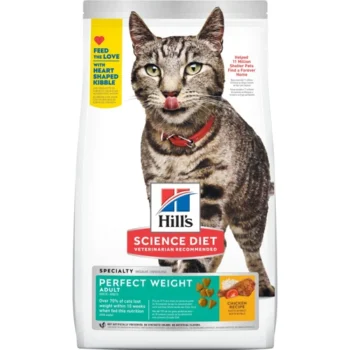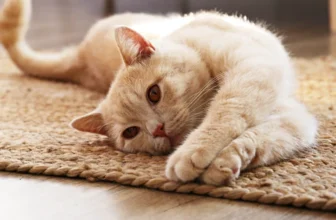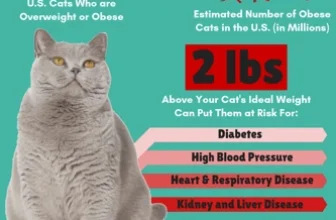Introduction
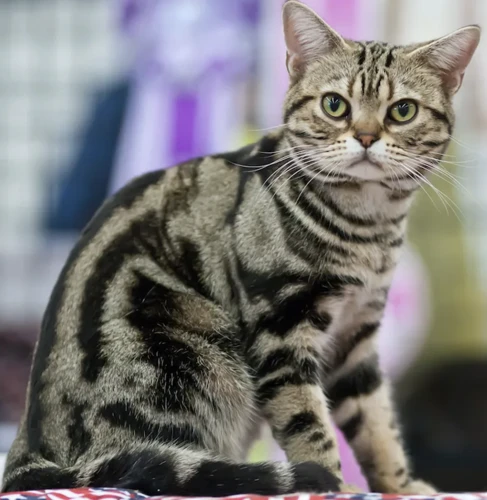
Starting a weight management program for your American Shorthair can be overwhelming and confusing. It is essential to ensure that your furry friend is receiving the proper nutrition while controlling their food intake. The solution lies in portion control, but what exactly does this mean? Why is it important for American Shorthairs? And how can it affect their weight management? In this article, we will answer these questions and provide you with step-by-step guidance on how to implement portion control in your American Shorthair’s diet.
What is Portion Control?
Portion control is the practice of measuring the amount of food an American Shorthair consumes at each meal. It is an essential component of weight management for cats that helps maintain a healthy body weight and prevents obesity. This method also allows you to manage your cat’s nutritional intake, ensuring that they receive the appropriate amount of nutrients per meal. Applying portion control measures can seem complicated at first, but with the right tools and knowledge, it can be easy to implement.
One method of portion control is to use measuring cups as a size guide for how much food to offer your cat. Placing food in a small bowl or plate that restricts the amount of food your cat can consume can also be used. By controlling their food intake, they will receive enough nutrition without overeating. Providing appropriate portions can improve your cat’s digestion and general health.
It is important to understand that portion control is not the same as limiting food. Controlling portion helps to balance calorie intake for long term health, while limiting food interferes with the nutritional value of the food.
When it comes to portion control, it is crucial to consider factors such as the age, activity level, and health status of your American Shorthair. Senior cats may require smaller portions due to decreased activity and metabolic rates. Kittens may require more food than adult cats to support their growth and development. You should also consider your cat’s body condition score to estimate how much food they need based on their weight.
Portion control is necessary for managing the weight of your American Shorthair cat. It is an effective way to ensure that your cat eats a balanced diet to maintain ideal weight and avoid health issues. Portion control not only controls the calorie intake but also provides a means of monitoring the nutritional intake of your cat ensuring they get the appropriate nutrients per meal. By consulting with a veterinarian and making simple changes like measuring food, pet owners can help their American Shorthair reach a healthy weight.
Why is it Important for American Shorthairs?
Maintaining a healthy weight through portion control is crucial for American Shorthairs due to several reasons:
1. Prone to Obesity: American Shorthairs are known for their love of food and can easily become overweight or obese if their diet is not monitored closely. Obesity can lead to various health issues, including joint problems, diabetes, and heart disease.
2. Health Issues: Being overweight or obese can put a significant strain on an American Shorthair’s body, impeding their quality of life and decreasing their lifespan. Health issues pertaining to weight management include hypertension, heart disease, and respiratory difficulties.
3. Improved Quality of Life: By implementing portion control and ensuring a healthy weight, American Shorthairs can improve their overall quality of life. They will be more active and energetic, leading to a happier and healthier lifestyle.
4. Cost-Effective: Maintaining a healthy weight through portion control can save pet owners money in the long run. A healthy cat will require fewer veterinary visits and less medication than their overweight counterparts.
By implementing strict portion control and ensuring a healthy weight for American Shorthairs, pet owners can help their cat to avoid obesity-related health issues. Regular exercise and a balanced diet also play an essential role in weight management. For more information on exercise for weight management, check out our article on /exercise-weight-management-american-shorthairs/.
How Does Portion Control Affect Weight Management?
Implementing portion control is an effective way to manage your American Shorthair’s weight. By regulating the amount of food that your cat eats, you can reduce the risk of overconsumption, which can ultimately lead to obesity. When a cat consumes more calories than it burns, the excess calories are stored as fat in the body, leading to weight gain. Portion control helps prevent overfeeding and promotes weight loss.
However, it is important to note that portion control should be approached with caution. Drastic reductions in food intake can lead to malnourishment and deficiencies. It is important to consult with a veterinarian before implementing any changes to your cat’s diet, including portion control.
By implementing portion control, you can ensure that your American Shorthair is consuming the appropriate amount of calories for its size and activity level. This can help your cat gradually lose weight and reach its ideal body condition score, which leads to better overall health.
In addition to portion control, other weight management strategies can also be applied, such as choosing the right cat food, encouraging exercise, and monitoring progress. By combining these strategies, pet owners can help their American Shorthairs reach their optimal health.
Internal link (anchor text: “obesity health issues”): Click here to learn more about the health risks of obesity in American Shorthairs.
Understanding Your American Shorthair’s Dietary Needs
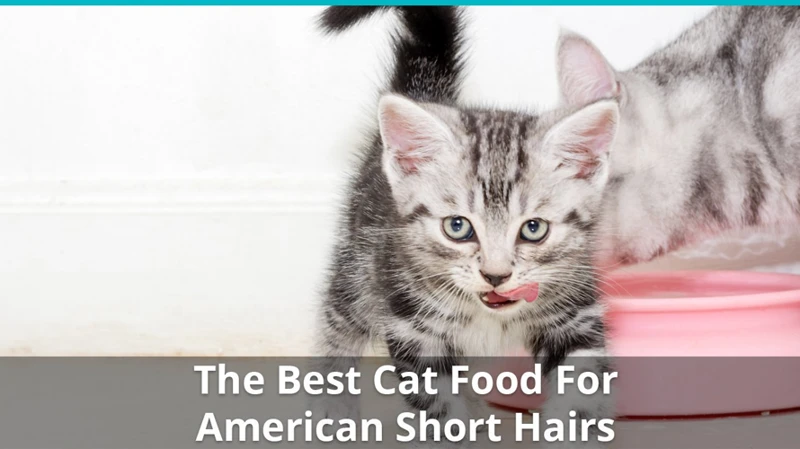
Understanding the dietary needs of your American Shorthair is crucial when it comes to maintaining their overall health and well-being. A key component of their diet is portion control, which we have already discussed. However, determining how much to feed your cat depends on several factors, including their ideal weight, age, and activity level. In this section, we will delve further into these factors and help you make informed decisions about your cat’s diet. Plus, we will discuss how to read cat food labels to ensure they are getting the right balance of nutrients. So, get ready to equip yourself with the necessary knowledge to keep your American Shorthair healthy and happy.
Determining Your Cat’s Ideal Weight
Determining Your Cat’s Ideal Weight
Determining your American Shorthair’s ideal weight is an important step in managing their weight effectively. It is vital to recognize what their weight should be before implementing a diet plan.
One way to determine your cat’s ideal weight is by consulting with your veterinarian. They will assess your cat’s body condition score and determine their ideal weight based on their breed, frame size, and activity level. A body condition score is a system that vets use to determine if a cat is underweight, overweight, or at their ideal weight. If you’re unsure what the ideal weight for your American Shorthair should be, consulting your vet will provide clarity and direction to begin helping your feline friend attain their best possible health.
Another way to determine your cat’s ideal weight is by checking breed-specific weight charts. For example, an adult American Shorthair cat should weigh between 8-15 pounds. However, these weight ranges are just generalizations, and your cat’s ideal weight may vary based on specific factors.
Once you have a good understanding of what your cat’s ideal weight range is, it’s essential to ensure that they stay within it for optimal health. Keeping your cat’s weight in check will help improve their energy levels, mental clarity, and overall body function.
To know how to maintain your American Shorthair’s ideal weight, continue reading the next section. Alternatively, you can check out the information on body condition score to learn more about determining your cat’s body weight.
Factors Affecting Your Cat’s Nutritional Needs
When it comes to American Shorthairs and their nutritional needs, there are various factors that need to be considered. These factors can impact the type of diet that your cat requires for optimal health and weight management.
1. Age: As cats age, their nutritional needs change. Kittens require more calories and protein for growth and development. On the other hand, senior cats may require fewer calories and more nutrients that support joint health and mobility.
2. Activity Level: Active cats that spend a lot of time playing and exploring will require more calories than those who are more sedentary.
3. Weight: The ideal weight for an American Shorthair varies depending on gender, age, and individual body composition. Maintaining a healthy weight is crucial for preventing a range of health problems in cats.
4. Health Conditions: Certain health conditions, such as diabetes or kidney disease, may require a special diet or specific nutritional considerations. Discuss with your veterinarian if your cat has any health issues.
5. Quality of Cat Food: The type and quality of food you feed your American Shorthair can significantly impact their nutritional status. A quality diet with high protein and low carbohydrates can support weight management and overall health.
By considering these factors, you can determine the best type and amount of food to feed your American Shorthair. Keep in mind that every cat is unique and may require a slightly different diet plan. Don’t hesitate to consult with your veterinarian or a feline nutritionist if you have any concerns about your cat’s diet.
Providing indoor activities for Shorthairs can also support them to maintain health and weight. Check our previous article about /indoor-activities-american-shorthair-health/.
Choosing the right treats is also important. Some healthy options for treats that can boost weight loss results are discussed on our next article. Read about it here: /health-treats-shorthairs-weight-loss/.
Remember, the goal of portion control and weight management for American Shorthairs is to keep them healthy, active, and happy. By adjusting their diet and lifestyle, you can help your cat reach and maintain their ideal weight for a long and healthy life. Prepare the ground for this journey by checking our /help-american-shorthair-lose-weight/ article.
Reading Cat Food Labels
When choosing cat food for your American Shorthair, it’s essential to read the labels carefully. Here are a few things to keep in mind while reading cat food labels:
- Ingredient List: Check the first few ingredients listed on the label. Foods high in protein should be at the top of the list. Avoid foods that list grains or fillers as their main ingredient.
- Calorie Content: Look for the calorie content per serving and compare with your cat’s daily caloric needs.
- Guaranteed Analysis: This section shows the minimum and maximum percentages of protein, fat, fiber, and moisture within the food. Make sure the protein percentage is high enough to promote healthy muscle maintenance and development for your cat.
- Nutritional Adequacy Statement: This statement indicates whether the cat food meets the minimum requirements for cats’ overall nutrition. Look for a statement that says the food is “complete and balanced.”
- Feeding Instructions: Follow the recommended feeding amounts based on the cat’s weight and activity level on the label.
Reading the labels of cat food can be confusing, so it’s important not to hesitate to reach out to your vet for recommendations. Your vet will be more likely to provide a more nuanced understanding of what you’re reading and what your cat needs. By finding the right cat food and monitoring the ingredients, you can help your American Shorthair maintain a healthy weight.
How to Implement Portion Control
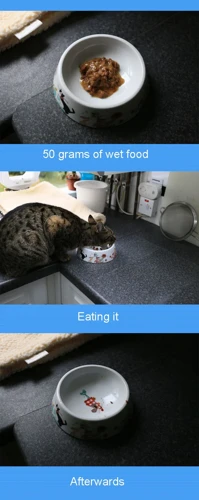
As American Shorthairs are prone to weight gain and obesity, implementing proper portion control is crucial for their overall health. However, figuring out how to do it can seem overwhelming. Fortunately, there are several steps you can take to implement portion control effectively. By following these guidelines, you can help your furry companion maintain a healthy weight and a happy life. Let’s delve deeper into these steps below.
Consulting Your Vet
Consulting your vet should be the first step you take when implementing portion control for your American Shorthair. Your veterinarian can help you determine the ideal weight for your cat and recommend the appropriate amount of food to feed. They can also help you navigate any health issues your cat may have that could affect their dietary needs.
It’s important to remember that every cat is unique and their nutritional needs may vary based on several factors. These include age, weight, activity level, and any health conditions or medications they may be taking. Consulting with your vet can help you get a more accurate picture of your cat’s individual needs.
During your vet consultation, you can expect to discuss your cat’s current diet and any concerns you may have. Your vet may also perform a physical exam and run bloodwork to check for any underlying health issues.
Table: Questions to Ask Your Vet During a Portion Control Consultation
| Question | Reason for Asking |
|---|---|
| What is my cat’s ideal weight? | To determine how much to feed your cat and set weight loss goals. |
| How many calories should my cat consume per day? | To determine an appropriate feeding plan based on your cat’s energy needs and weight loss goals. |
| Are there any health conditions that could impact my cat’s dietary needs? | To ensure your cat’s dietary needs are being met and any necessary adjustments are made to their diet. |
| What type of cat food do you recommend? | To ensure your cat is receiving a balanced and complete diet and to address any dietary concerns you may have. |
Consulting with your vet is crucial for ensuring that your cat’s portion control plan is tailored to their individual needs. Your vet can provide personalized recommendations and monitor your cat’s progress to ensure they remain healthy and happy.
Calculating Your Cat’s Caloric Needs
When it comes to portion control, calculating your American Shorthair’s caloric needs is crucial. This will ensure that you’re feeding your cat the right amount of food to maintain a healthy weight. However, determining the right amount of calories can be a bit perplexing. To make it easier for you, here are the steps that you can take to calculate your cat’s caloric needs:
Step 1: Identify your cat’s weight
The first step to calculating your cat’s caloric needs is to determine their current weight. You can do this by weighing your cat on a scale. If you’re uncertain about whether your cat’s weight is healthy, consult your vet.
Step 2: Determine your cat’s activity level
The second step is to assess your cat’s activity level. Is your cat mostly sedentary, or do they get a lot of exercise? This will help you determine their daily caloric needs. A sedentary cat will require fewer calories than a cat that’s active all day.
Step 3: Use a calorie calculator
There are several online calorie calculators that can help you determine your cat’s daily caloric needs. These calculators take into account your cat’s weight, activity level, and other factors. Simply input the required information, and the calculator will give you an estimate of how many calories your cat needs.
Step 4: Adjust the amount of food you’re feeding your cat
Once you’ve determined your cat’s daily caloric needs, you can adjust the amount of food you’re feeding them. This may require some trial and error. Start by measuring out the recommended amount of food and monitor your cat’s weight over the next few weeks. If they’re losing weight too quickly, increase the amount of food slightly. If they’re not losing weight, decrease the amount of food.
Step 5: Regularly re-calculate your cat’s caloric needs
Your cat’s caloric needs will change as they age, become more or less active, and gain or lose weight. Be sure to recalculate your cat’s daily caloric needs periodically to ensure that you’re still feeding them the right amount of food.
By following these steps, you can ensure that you’re feeding your cat the right amount of food to maintain a healthy weight.
Measuring Your Cat’s Food
Measuring your cat’s food is a key element in maintaining portion control. It ensures that you are providing the right amount of food based on your cat’s specific needs, which can help prevent overeating and weight gain.
Step 1: Consult with your vet. Your vet can help you determine the appropriate amount of food for your American Shorthair based on their age, weight, and activity level. They may also provide specific recommendations on the type of food and feeding schedule that is best for your cat.
Step 2: Use an accurate measuring cup. Avoid using guesswork or estimation when measuring your cat’s food. Invest in a measuring cup to ensure accuracy. Using a standard kitchen measuring cup may not provide accurate measurements since pet food may come in slightly different shapes and sizes.
Step 3: Use a digital scale. Another way to measure your cat’s food accurately is by using a digital scale. Make sure to weigh the food in grams or ounces. The scale should also be calibrated regularly to ensure accuracy.
Step 4: Follow the feeding guidelines on the food label. Pay attention to the feeding guidelines on the label of your cat’s food. These guidelines typically provide recommendations based on your cat’s weight and activity level, and can be used as a starting point for portion control.
Step 5: Adjust portions based on your cat’s needs. As your American Shorthair’s weight changes over time, make sure to adjust their food portions accordingly. Consult with your vet if you are unsure about how much to adjust their portions by.
To make it easier to measure your cat’s food, consider using an html table like the one below:
| Cat’s Weight | Daily Food Portion |
|---|---|
| 5 lbs | ¼ – ⅓ cup |
| 10 lbs | ½ – ⅔ cup |
| 15 lbs | ¾ – 1 cup |
Remember, portion control is an essential part of weight management for American Shorthairs. Measuring your cat’s food accurately can help ensure that they receive the appropriate amount of food to maintain a healthy weight.
Feeding Multiple Cats
Feeding multiple cats requires a bit more attention to ensure that portion control is being followed for each individual cat. It’s important to avoid free-feeding, where food is left out all day for cats to graze on as they please. Instead, it’s recommended to feed cats separately and use portion control to regulate their food intake.
One approach is to use individual feeding stations. Each cat should have its own dish and feeding area, which will help prevent competition and overeating. Another option is to use timed feeders that automatically dispense a set amount of food at designated intervals.
Using measuring cups or a digital scale to portion out the food can also ensure that each cat is receiving the appropriate amount. It’s important to monitor the cats during feeding time to make sure that they are not attempting to eat each other’s food.
It’s also necessary to take into consideration the fact that cats have different nutritional needs based on their age, weight, and activity level. It’s recommended to consult with a veterinarian to determine each cat’s ideal food portions and frequency of feeding.
Below is a table for general guideline on how much to feed multiple cats based on their weight:
| Cat Weight | Daily Food Intake for 1 Cat (in 24 hours) | Daily Food Intake for 2 Cats (in 24 hours) | Daily Food Intake for 3 Cats (in 24 hours) |
|---|---|---|---|
| 4-6 lbs | 1/4-1/2 cup | 1/4-1/3 cup per cat | less than 1/4 cup per cat |
| 7-9 lbs | 1/2-2/3 cup | 1/3-1/2 cup per cat | 1/4-1/3 cup per cat |
| 10-12 lbs | 2/3-3/4 cup | 1/2-2/3 cup per cat | 1/3-1/2 cup per cat |
| 13-15 lbs | 3/4-1 cup | 2/3-3/4 cup per cat | 1/2-2/3 cup per cat |
It’s important to keep in mind that this is just a general guideline and each cat’s ideal food intake may vary. It’s always recommended to consult with a veterinarian for personalized recommendations.
Additional Weight Management Tips
As important as portion control is for maintaining a healthy weight in American Shorthair cats, there are additional practices that can also assist in weight management. By incorporating these tips into your cat’s lifestyle, you can help them maintain a healthy weight and prevent potential health issues. Here are some helpful weight management tips for your American Shorthair cat.
Choosing the Right Cat Food
As important as portion control is for weight management in American Shorthairs, choosing the right cat food is just as crucial. Your cat’s diet should be balanced and provide all the necessary nutrients for their health.
What to Look for in Cat Food
When selecting cat food, look for high-quality protein sources as the main ingredient, preferably from animal sources like chicken, turkey, or fish. It’s important to avoid cat foods that contain fillers such as wheat, corn, or soy, as these ingredients can cause digestive issues and are not as nutritionally beneficial. Additionally, look for cat foods that are specifically formulated for weight management, as they will have fewer calories and the appropriate balance of macronutrients.
Wet vs. Dry Cat Food
Many cat owners debate between feeding their cats wet or dry food. Both options have pros and cons. Dry food tends to be more affordable and easier to store, but it can be less appealing to cats who have a harder time staying hydrated. Wet food, on the other hand, contains more moisture and can be more palatable to picky eaters. However, it can be more expensive and spoil more easily.
Cat Food Brands
There are many cat food brands on the market, making it difficult to know which one to choose. Some popular brands that offer weight management options include Hill’s Science Diet, Purina Pro Plan, and Royal Canin. It’s important to do your research and choose a brand that sources high-quality ingredients and has a good track record of producing nutritious cat food.
Here’s a table to summarize what to look for when choosing the right cat food:
| What to Look for | Why It’s Important |
|---|---|
| High-quality protein sources | Provides necessary nutrients for health |
| No fillers like wheat, corn, or soy | Avoids digestive issues and provides better nutrition |
| Specifically formulated for weight management | Has appropriate balance of macronutrients and fewer calories |
Choosing the right cat food is essential for weight management in American Shorthairs. Look for a brand that sources high-quality ingredients and provides a balanced diet that meets your cat’s nutritional needs. With the right food, portion control can have an even greater impact on your cat’s weight management journey.
Encouraging Exercise
It is important to note that portion control alone may not be enough to maintain your American Shorthair’s weight. Encouraging exercise is also crucial for weight management. Exercise not only helps burn calories, but it also promotes overall health and well-being.
One way to encourage exercise is to provide your cat with interactive toys such as balls and feather wands. This can help stimulate your cat’s natural hunting instincts and keep them active. Try to incorporate at least 15-20 minutes of playtime with your cat each day.
Another way to encourage exercise is to provide your cat with a climbing tree or scratching post. This can help promote physical activity and provide mental stimulation for your cat. Make sure to choose a sturdy and stable climbing tree to ensure your cat’s safety.
If your cat is an indoor cat, consider providing them with a window perch so they can watch the birds outside. This can help stimulate their mind and provide entertainment while still promoting physical activity.
Table:
| Ways to Encourage Exercise | Benefits |
|---|---|
| Provide interactive toys | Stimulates natural hunting instincts, keeps cat active |
| Provide a climbing tree or scratching post | Increases physical activity, provides mental stimulation |
| Provide a window perch | Stimulates mind, provides entertainment, promotes physical activity |
Remember, encouraging exercise is an important part of weight management and overall health for your American Shorthair. Be sure to consult with your vet before implementing any exercise routine.
Monitoring Your Cat’s Progress
As with any weight management program, monitoring progress is crucial to ensure success. Here are some tips for monitoring your American Shorthair’s weight loss progress:
- Weekly Weigh-Ins: Regular weigh-ins can provide a good indication of whether your cat is losing, gaining, or maintaining weight. Use a digital scale specifically made for pets and try to weigh your cat at the same time each week. Record the weight in a journal or spreadsheet to track any changes.
- Body Condition Scoring: Another way to monitor your cat’s progress is to assess their body condition. Use a body condition score chart to evaluate your cat’s body shape and fat cover, and note any changes over time.
- Assessing Energy Levels: If your cat is losing weight, you should notice an increase in their energy levels and activity. If they seem more lethargic than usual, they may not be getting enough food. On the other hand, if they are still overly active or hyper, they may be getting too many calories.
- Adjusting Portion Sizes: Based on your weekly weigh-ins, body condition scoring, and energy level assessments, you may need to adjust your cat’s portion sizes. Your vet can help you determine the right amount of food for your cat based on their weight, age, and activity level.
- Consulting Your Vet: If you notice significant changes in your cat’s weight or behavior, or if they are not losing weight despite portion control and exercise, consult your vet for further advice. They may recommend additional testing or a different weight management plan.
Remember, weight management is a gradual process, and it’s important to have patience and stick to a consistent plan. With the right diet, exercise, and monitoring, your American Shorthair can achieve and maintain a healthy weight for a long, happy life.
Conclusion
After reading this article, it should be clear that portion control is essential in weight management for American Shorthairs. Overfeeding your cat or giving them too many treats can result in obesity and health problems. It’s important to understand your cat’s dietary needs and consult with a veterinarian to calculate the right amount of calories for your cat’s ideal weight.
Implementing portion control may seem daunting at first, but it is necessary for your cat’s long-term health. Measuring your cat’s food and encouraging exercise can help them maintain a healthy weight and prevent health problems in the future. Additionally, choosing the right cat food and monitoring your cat’s progress can aid in weight management.
Remember that every cat is different, and it may take some trial and error to find the right amount of food for your American Shorthair. Do not hesitate to consult with your vet throughout the process.
By implementing portion control and following the weight management tips outlined in this article, you can help your American Shorthair live a longer, healthier life. Take control of your cat’s diet today and watch their health improve over time. Your cat will thank you for it.
Frequently Asked Questions
What should the ideal weight be for an American Shorthair?
The ideal weight for an American Shorthair can vary depending on their age, sex, and overall body structure. However, a healthy weight range is typically between 8 to 12 pounds.
What are some health problems associated with obesity in cats?
Obesity can lead to several health problems in cats, including diabetes, joint problems, and heart disease.
Can American Shorthairs overeat?
Yes, American Shorthairs are prone to overeating. This is why portion control is so important in their weight management.
What should be included in a healthy cat diet?
A healthy cat diet should include a balance of proteins, fats, and carbohydrates. Specifically, American Shorthairs require a protein-rich diet with moderate fat content.
Is wet or dry food better for weight management?
Both wet and dry food can be good options for weight management, but wet food tends to have fewer calories. However, it’s important to make sure your cat is getting the necessary nutrients regardless of the type of food you choose.
Should cat treats be included in portion control?
Yes, treats should be included in portion control. They can be a source of extra calories that can contribute to weight gain if not given in moderation.
How much should I increase my cat’s exercise for weight management?
Increasing your cat’s exercise by just a few minutes each day can make a significant difference in weight management. Try incorporating interactive toys or games that encourage physical activity.
Should I consult with my veterinarian before implementing portion control?
Yes, it’s important to consult with your veterinarian before implementing portion control or any weight management strategy. They can help determine the appropriate caloric intake and offer advice tailored to your cat’s individual needs.
What are some signs that my cat is overweight or obese?
Signs of overweight or obesity in cats can include difficulty jumping, increased lethargy, and a visibly rounder belly.
Is it possible for an American Shorthair to lose weight with portion control alone?
Yes, it is possible for an American Shorthair to lose weight with portion control alone. However, it’s important to make sure they’re still receiving a balanced diet and enough nutrients.

